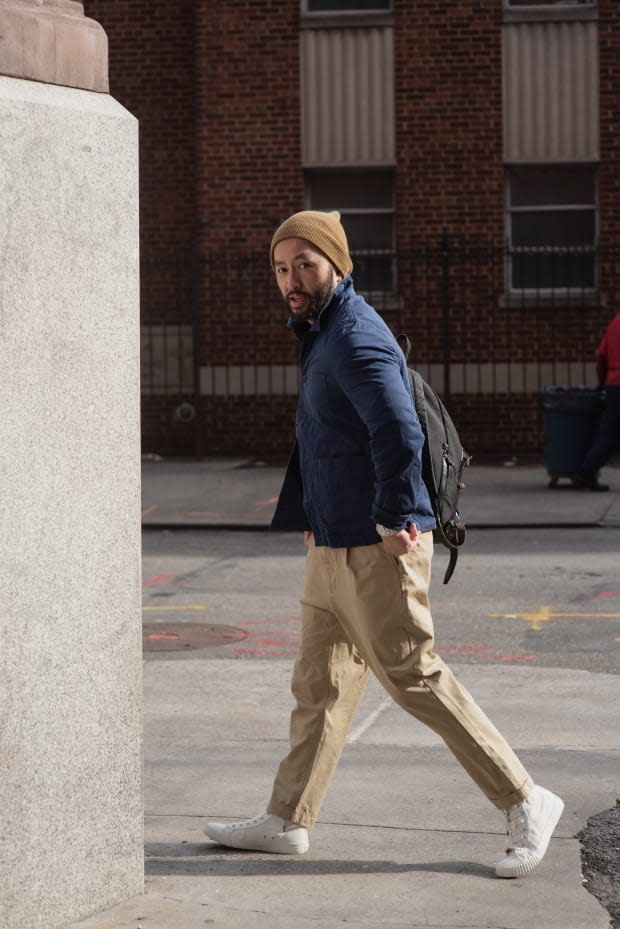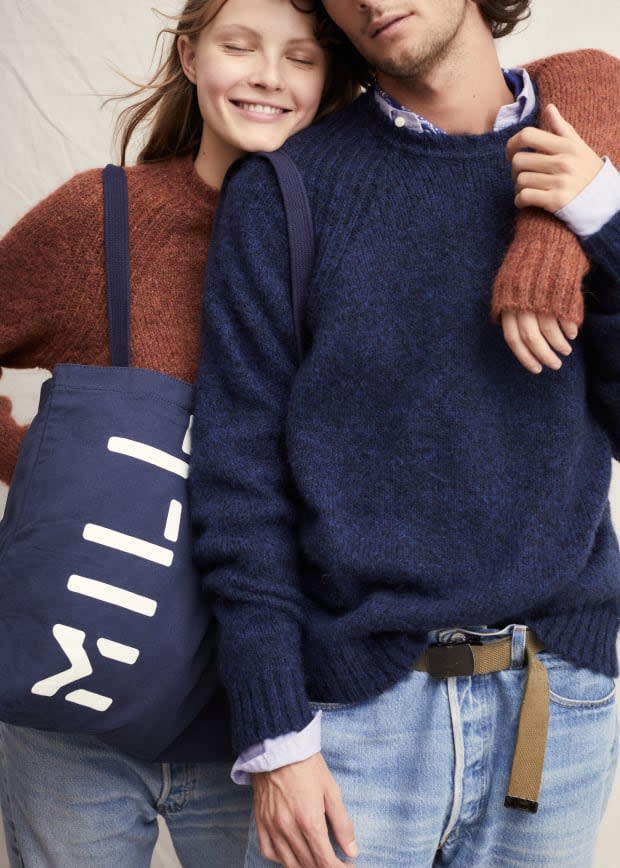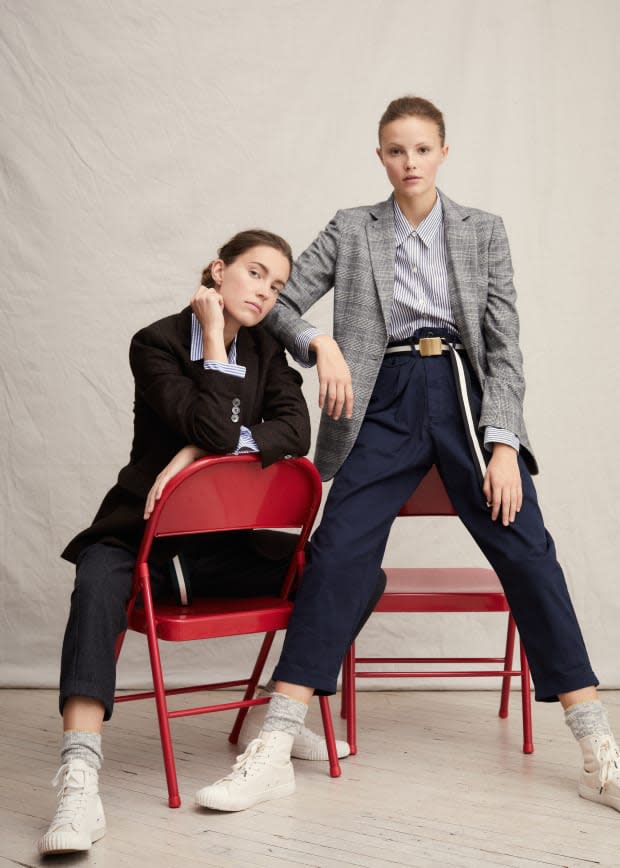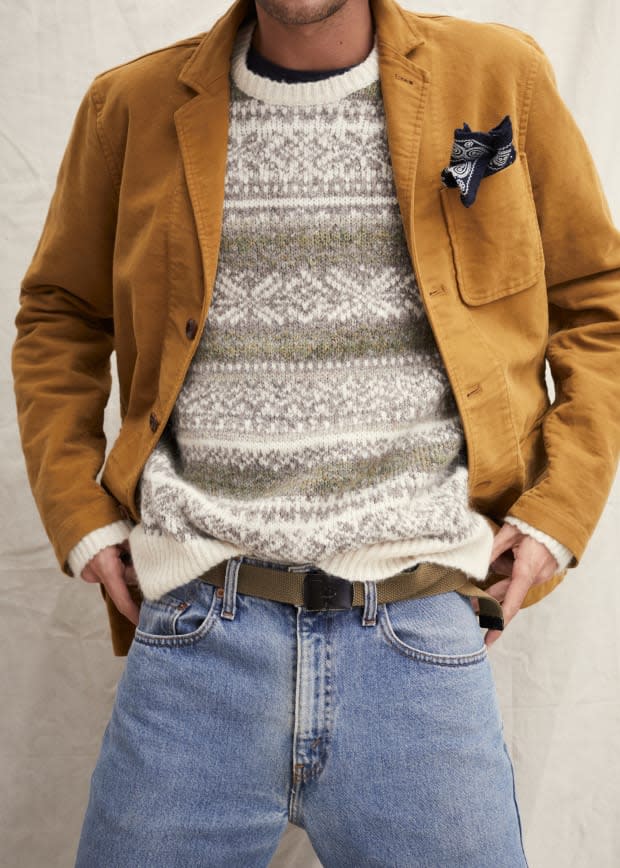How Somsack Sikhounmuong Went From Sneaking Into Fashion Week to Redefining Fashion's Basics
The Toronto native left a 16-year run at J.Crew to relaunch Alex Mill, where easy-to-wear staples are the name of the game — and his calling card.

In our long-running series "How I'm Making It," we talk to people making a living in the fashion and beauty industries about how they broke in and found success.
If the Fashionista office had any semblance of a uniform from the years 2015 to, say, 2017, it was Somsack Sikhounmuong's Madewell. I say this not to sing Madewell's praises from the rooftops, but because Sikhounmuong, as the brand's then-head of design, could do the impossible: enthusiastically outfit a room full of women with very different tastes, styles and bodies in one label's attire. Presumably, this is why Madewell's big-sister brand, J.Crew, tapped Sikhounmuong to replace the inimitable Jenna Lyons as its chief design officer after her sudden departure in April 2017.
It also probably didn't hurt that between his time at both Madewell and J.Crew, he'd been at J.Crew Group for more than 15 years — a celebrated tenure in an era where young creatives often hopscotch around roles and employers so to scale the career ladder. But in September 2017, Sikhounmuong left the mothership and departed the company entirely, and after taking some time off, resurfaced this past February at the forefront of a new, fresh-slate-worthy kind of project: relaunching Alex Mill, a label that describes itself as being "a well-crafted assortment of classic essentials."
Alex Mill, which has been around since 2012, was co-founded by Alex Drexler, the son Sikhounmuong's retail-mega-famous mentor, former CEO and chairman of the J.Crew Group Mickey Drexler. Indeed, the brand had a committed following (not to mention a lucrative brick-and-mortar location on New York City's Elizabeth Street), and yet, Alex Mill hadn't offered womenswear until Sikhounmuong got involved. Now, though, it does, with that same versatility we loved in his Madewell days coursing through the cotton-twill jumpsuits you've definitely seen up and down Manhattan. (It's even launching a four-piece kidswear capsule for holiday, out on Wednesday, including a so-cute-mini-version of that same jumpsuit.)
"What I love about our clothes is that you can wear them any way and they lend themselves naturally to serve your interpretation," says Sikhounmuong. "I saw a girl the other day wearing a black jumpsuit with a blazer over it. From the back it looked like nothing, but from the front, I was just like, ‘That is cool.'"
But before all that, Sikhounmuong was just a kid from outside Toronto collaging fashion magazines, a kid who eventually made it to New York City, disposable camera in hand, to study at Parsons School of Design — and who made it big. I spoke to him about all of that, going back to the very beginning. Read on for the highlights.

What first interested you about fashion?
The town I grew up in was very blue collar. It was automotive-related — the second largest GM plant was there — so it was, I would say, the opposite of "fashion." Growing up, my mom was a seamstress and my grandma made clothes for us. When it was our birthday, they'd take us to Joann Fabrics and my sister and I would pick a fabric and she'd make a shirt for us. So I think innately, it was always in our family, but I never wanted to do fashion. I knew I wanted to do something artistic. I knew I wanted to draw; I knew I wanted to paint, scribbling all over the walls and stuff. And they'd be my scribbles, unfortunately.
Do you have a first fashion memory?
My sister and I were in third grade or something, and there was a stack of fashion magazines in the back of the classroom that the teacher had brought in as a tool for students to cut up. But instead of chopping them up and collaging the magazines, my sister and I would bring them home and just stare at them — sort of rescue them from this dire fate they had been assigned. We would amass a huge collection of these fashion magazines and we would look at them at home.
I remember seeing Marc Jacobs in there, Isaac [Mizrahi] in there, Geoffrey Beene in there, all these really great American designers. And I would always notice the word "Parsons" in a lot of their biographies. So I was like, "Well, I guess if I want to be in fashion, I better get my butt to Parsons in New York." I think that's probably how it all started — just the idea of, "Okay, if I want to do this seriously, I'd better get a degree in it and start being creative."
Related Articles
Factory Tour: Inside the Denim Factory Your Favorite Sustainabile Brands Use Loyally
J.Crew Hopes Sustainability Progress at Madewell Will Attract Investors Ahead of IPO
How Rachel Antonoff Became a Famously Creative Fashion Force Without Ever Losing Her Way
Once you got to Parsons, what were your first steps getting into the industry?
I was there in the mid-nineties, so it was a very different time. When I first got there, I heard there were fashion shows happening up at Bryant Park. I remember one day going to Duane Reade, buying a disposable camera and taking the N train all the way up to Times Square, then walking over to Bryant Park and just standing outside and looking at all the models. I was a model fanatic, a crazy model fanatic. I knew everyone's names. I would stand outside hoping to crash a show; I would take pictures of models and observe editors and learn their names, seeing what the process of fashion in New York was like back then. It was a huge learning experience.
I remember a friend saying to me after Vogue.com published [the images], "Imagine if someone came to you as you were taking those photos as a fashion student and told you, ‘You know the photos you're taking right now? Fast-forward 20 years — they're going to be on Vogue." I would've exploded. I was just doing my thing because I loved models so much. Who knew what was going to happen to those photos? Somehow, because I loved it so much, it manifested itself in a really amazing way.
Just being outside with these models and editors, so many of them looked so good without trying very hard. They were working and they were still stylish. So the idea of real clothes and real uniforms has informed a lot of what I do or what I've done in the places I've worked. But especially at Alex Mill now.
It's become so commonplace for young creatives to move around jobs in order to progress in their career, but you were at J.Crew and Madewell for 16 years. What was it like to stay rooted in one place for so long?
When you're at a place that fosters your growth and your creativity, there's never really a reason to think about any other opportunity. The leadership was amazing. Mickey [Drexler] wasn't there when I first started, but he came in and flipped the table. He was always very supportive of me and what I was doing, my team and the design team. I've always been fascinated by people who've hopped around a little bit because I've never had that experience and I felt like I've never needed to. I've hopped around departments in the building and was able to do various things, from accessories to Madewell to women's to a little bit of men's at the end. But I had that experience under one umbrella with great leadership and a great team.

You worked in both accessory and apparel design in your first years at J.Crew. What did you learn about accessories that have impacted what you do for apparel, and vice versa?
Both require very different creative muscles. Oftentimes with accessories, it's the icing on the cake. But with apparel, it's the batter that goes into the cake. And women shop very differently for each thing. Women will save for a great, great, great bag. The idea of bringing value to people with great quality, whether it was apparel or accessories, was always the thing we focused on. And it's still the same thing we do now.
But at the end of the day, people just want really emotional product. A product that’s going to tug at their heart, but also be very affordable, to be universal enough to wear and use all the time. Wearable is always important for us, for me as a designer.
From there, you went on to lead Madewell, and Madewell was always a very bright spot for the business. What was like heading up such a buzzy brand?
The customer is always a huge part of what I do, and I don't ever love to design in a vacuum. Once you put something out as a designer, the next thing you hope for, and you cross your fingers for, is a positive reaction from customers. The brand had existed for a little bit, so I took over seven years into it. We edited things, got a new point of view, made denim a bigger conversation and made everything much more emotional, but still very wearable. And people were responding to it. There's no bigger compliment than to be able to do something you love and then have people say, "Wow, we love what you're doing." I don't know what else is better than that.
After leaving the company, you took some time off before teaming up with Alex Drexler to relaunch Alex Mill and expand into women's. How did that opportunity come about?
I left in October and Mickey had left in July. We've always kept in touch here and there. In addition to being the advisor or the mentor that he was at J.Crew, I joked that when I left, he became my agent or my employment agency. [Laughs] He was always calling me, checking in on me, seeing how I was doing and if I was open to meeting with people. I don't think I took anything seriously until, probably, January. I'd taken a month off, traveled a little bit in Thailand with my family and then came back.
I was standing in line at Whole Foods one day when Mickey called me. He was like, "Hey, I'm thinking a lot about Alex Mill. Are you familiar with it?" I said, "Of course." I'd been to the shop on Elizabeth Street a few times. I bought some stuff — it was really great stuff! He was like, "Why don't you meet with my son, Alex Drexler? I feel like there's huge potential. I think you guys would click. Why don't you meet with him and just see what happens?"
That was in January, and we got to talking. There were a lot of common values and shared interests. We talked about what we felt was missing in the industry and in the fashion landscape. We thought there was an opportunity in fashion at that time for really good clothes that aren't over-designed, over-complicated, that felt relevant and personal and emotional, that you'd want to wear forever.
We left thinking, let's re-pivot the brand and add women's. I learned there were a lot of women coming into the men's-only Alex Mill store and asking if they carried women's. We didn't at that time, but still, a lot of the women were buying the men's stuff. I found that very interesting, and I've always loved this tomboy-ish, unisex way of dressing.

Like J.Crew, Alex Mill is rooted in easy-to-wear, everyday classics. How do you define that genre, and how do you think that category has evolved?
One of the taglines we use all the time — and something I personally felt having had time off — was the idea of people waking up each morning, getting dressed and not having to overthink things. That's a very American way of getting dressed. It's not boring classics. It's classics with a little bit of emotion. I feel like there was a lot of either very basic or very trendy stuff out there. To be relevant to someone's life today, I wanted to make sure that the clothes were emotional enough that people would want to invest their money, but still be classic enough where you weren't going to get rid of them in two or three weeks. That always feels very American to me, going back to the idea of a great pair of chinos with a great T-shirt, and having that be the base of everyone's closet. Clothes that you're able to buy and wear and do stuff in, live life with.
I really believe that. Being at Alex Mill now, the scale of what we're doing each day is much smaller, and it's a much more focused point of view. It's an edited offering, which then lets us as designers take more time to design each piece. We make sure each piece feels great. That kind of time as a designer is so important. That's been a great perk of being in a small startup. It's just a very different way of working.
How do you apply what you learned early on in your career to what you're doing now for Alex Mill?
Oh gosh, there's been so much. A good edit is so important. Being able to lead something with a point of view so that you get recognized for it, so that people come to you for your point of view. Creativity and style, no matter where you work or what company you're designing for, whether it's big or small. That's always been important to me, to design something that feels immediate, that feels relevant, that's not going to be looked over. To have a coat you pick up and you're just like, "Wow, this fits really great. The fabric feels good. Look at this little detail." Something that makes you smile.
What do you think has been the biggest change in the industry today versus when you started?
The digital world is an obvious thing. That’s great, but it also has its own challenges, too. I love the reach you have as a small brand. Your store can be accessed from anywhere around the world. And how amazing is that, to be able to have a customer DM you on your phone via your Instagram account, and to be able to answer that within seconds? It’s incredible. That kind of reach has been amazing. There have been new opportunities to be much more personable with each customer, to give them that personal touch. You're accessible to so many people, and I think that's kind of awesome.
What challenges do you still face?
To piggyback off what we just said, just getting our name out there as a small brand. There's so many options, and I think there's so much noise. How do we cut through? I always go back to the emotional component of what we do. I feel like we do something very special, but now we have to try to get that out to people. I like to think we're doing it in a very macro way, but doing that in a very micro way. It's always important to use the digital world to get your name out there, through wholesale and all that. But then on the other hand, we opened up a temporary store in SoHo. It's been so great being able to go in and meet people and talk to people face to face and find out what they love about the brand or what they don't love about the brand. To solely do one or the other is not great. But I think it's important to have both, to constantly be using both the macro and the micro.
What's your ultimate goal for yourself?
A lot of people have asked, "What's your long-term plan?" And I've never really been the sort of person who has ever thought that far ahead. I'm the person who's just taking each day, day by day. I love the idea of letting things grow organically in the long-term, taking things as they come. But in the meantime, getting people in our clothes has been a huge reward and a focus of ours. To see someone on the subway in your jumpsuit or to hear that someone had bought something for their mom and she loved it. Or to meet the guy who was wearing our blazer and he came in for a second one. All that stuff has been very organic, but so rewarding. I wouldn't ever say it was a goal, but it's been a very nice thing to hear.
What career advice would you give to young designers today, especially having so much access to the industry through social media?
It's the same advice I'd give today as I would have given 10 years ago. Creativity, thinking out of the box, being curious is so important. Nothing exists in a vacuum anymore. You have access to anyone and anything in the world. Go out and see other things, how other people are working; best practices exist in any industry. And also more importantly, always surround yourself with great people and a great team. One of the biggest things I learned being in a startup is that you can't do it all by yourself. You do a lot, but at the end of the day, it's a team effort and it will always be.
This interview has been edited and condensed for clarity.
Never miss the latest fashion industry news. Sign up for the Fashionista daily newsletter.
